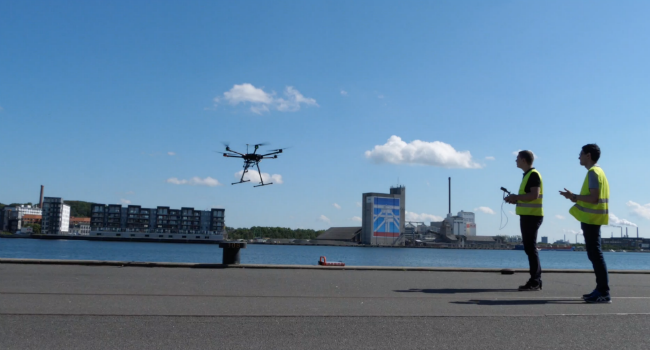The mobile network of the future can be used to control flying drones on various missions such as flying blood samples between hospitals. ‘This is an obvious possibility,’ says Rafhael Medeiros de Amorim, who recently completed his PhD in wireless network communication at Aalborg University (AAU).
‘You could use time and effort to build a special network only for drones, but that wouldn’t make any sense. You could also use satellites to control drones, but satellites have limited capacity and are very expensive to use,’ he explains.
RELIABLE FLYING POST
Rafhael Medeiros de Amorim believes flying drones will play a major role in future transport systems. Particularly when it comes to the delivering packages, rapid transport of vital samples between hospitals or other emergency applications.
Drones are controlled with radio waves that have a limited range. It is thus illegal in Denmark and most of Europe to use a drone that goes outside the controller’s field of vision. The risk of losing control of the drone and causing an accident is simply too great.
The field-of-vision rule restricts the use of drones in cities and other densely built areas. Finding a safe, alternative way to control flying drones is therefore crucial to drone technology.
‘The task is to find a reliable communication channel that can handle the necessary data flow to and from the drone in real time – even if it disappears from your field of vision’ Rafhael Medeiros de Amorim explains.
FLEXIBLE NETWORK MEANS MORE ACTORS
By controlling drones through mobile networks, drones can be used for many more tasks.
‘As things stand now, where drones can only fly within the operator's sight range, the range of a drone for, say, package delivery or rapid transport of samples from one hospital to another is very limited. With access to a secure, fast and flexible network that doesn’t cost a fortune to use, it will mean many more players joining the drone market and that drones will be used to solve many more different tasks,’ he says.
SIGNAL PROCESSING NEEDS IMPROVEMENT
If mobile networks can be used to control flying drones, it will potentially be an important step for expanding the use of drones for more practical tasks in urban areas. Mobile networks will be widely used everywhere, and drones using the networks on equal terms with all other devices makes them cheap to use. There is also much to suggest that the networks are very suitable for controlling drones. The risk of losing the signal is quite small.
‘One of the things we’ve noticed in our test is that the connection between the drone and the mobile network is very different from the connection between a phone and the network. Since a drone hovers in the air, the signals from the multiple mobile transmitters are not blocked by buildings, trees, vegetation or landscape; this makes for significantly more interference in the signal,’ says Rafhael Medeiros de Amorim.
However, it does involve a certain amount of risk. He explains:
‘We need to develop network solutions that take communication with flying drones into consideration, and not just the telephones on the ground that have been the focus of network developers for decades. Now we need to develop systems that also address the drones’ network access. With the pace of development of mobile networks and drones, I think we can have a safe way of controlling drones over mobile networks within the next three to five years.’
CONTACT:
Rafhael Medeiros de Amorim, PhD, Department of Electronic Systems, AAU, + 45 8194 8488
Preben Mogensen, Professor, Department of Electronic Systems, AAU, pm@es.aau.dk, + 45 9940 8658
Nelly Sander, Press Contact, Technical Faculty of IT and Design, AAU, nsa@adm.aau.dk, + 45 9940 2018

